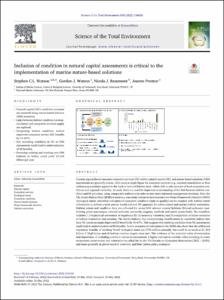Inclusion of condition in natural capital assessments is critical to the implementation of marine nature-based solutions.

View/
Average rating
votes
Date
2022Author
Watson, Stephen C.L.
Watson, Gordon J.
Beaumont, Nicola J.
Preston, Joanne
Metadata
Show full item recordAbstract
Current approaches to measure ecosystem services (ES) within natural capital (NC) and nature-based solutions (NbS)
assessments are generally coarse, often using a single figure for ecosystem services (e.g., nutrient remediation or blue
carbon sequestration) applied to the local or national habitat stock, which fails to take account of local ecosystem conditions
and regional variability. As such, there is a need for improved understanding of the link between habitat condition
and ES provision, using comparable indicators in order to take more informed management decisions. Here the
UK, Solent Marine Sites (SEMS) is used as a case study system to demonstrate how Water Framework Directive (WFD)
‘ecological status’ and other indicators of ecosystem condition (state or quality) can be coupled with habitat extent
information to deliver a more precise locally-tailored NC approach for active coastal and marine habitat restoration.
Habitat extent and condition data are collected for sev.....
Journal
Science of the Total EnvironmentVolume
838Issue
Article 156026Page Range
11pp.Document Language
enSustainable Development Goals (SDG)
14.aMaturity Level
Pilot or DemonstratedSpatial Coverage
SolentUK waters
DOI Original
http://dx.doi.org/10.1016/j.scitotenv.2022.156026Citation
Watson, S.C.L., Watson, G.J., Beaumont, N.J. and Preston, J. (2022) Inclusion of condition in natural capital assessments is critical to the implementation of marine nature-based solutions. Science of the Total Environment, 838: 156026, 11pp. DOI: https://doi.org/10.1016/j.scitotenv.2022.156026Collections
The following license files are associated with this item:
 Repository of community practices in Ocean Research, Applications and Data/Information Management
Repository of community practices in Ocean Research, Applications and Data/Information Management
